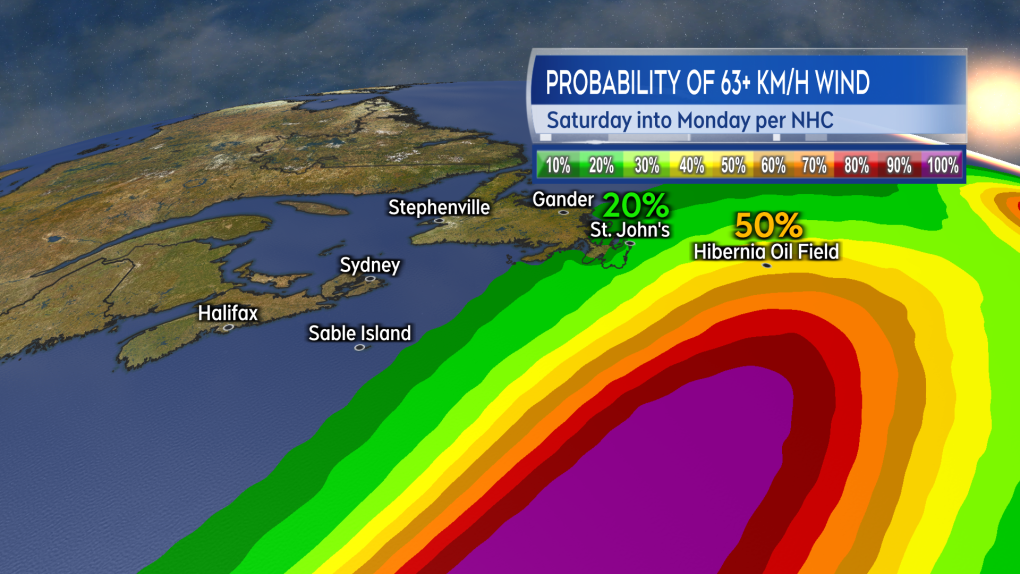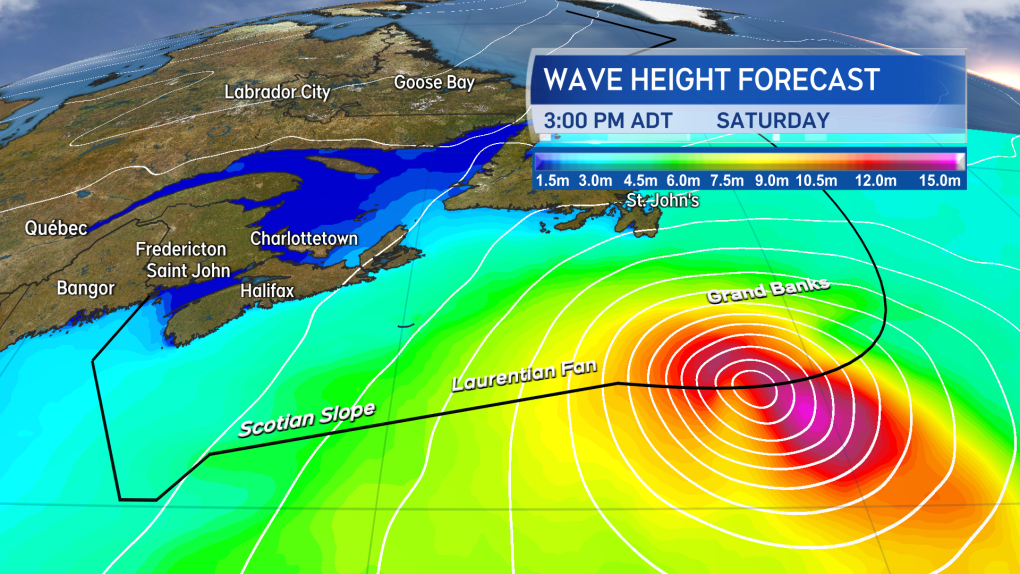Powerful Hurricane Earl forecasted to pass east of Maritimes

Hurricane Earl has increased in strength to become a category two hurricane with maximum sustained winds in the eye of the storm near 165 km/h as it moves to a position 365 kilometres south of Bermuda Thursday.
The hurricane is entering an environment of warm ocean water temperatures and light wind shear which will allow it to continue to intensify. The latest forecast from the National Hurricane Center has Earl reaching category three as early as Thursday evening and category four with maximum sustained winds near 215 km/h as early as Friday evening as it moves northeast of Bermuda.
 A high-resolution satellite image of Hurricane Earl positioned to the south of Bermuda Thursday afternoon.
A high-resolution satellite image of Hurricane Earl positioned to the south of Bermuda Thursday afternoon.
While passing to the east of Bermuda, the island is expected to experience tropical storm conditions beginning Thursday afternoon and extending into the evening. That would include sustained winds near, or in excess, of 65 km/h and rain that could total 25 to 75 mm. A Tropical Storm Warning and Hurricane Watch are in effect for Bermuda.
Should Earl reach category three, it will be the first major hurricane (category three or higher) of the 2022 Atlantic Hurricane Season.
![]() The forecast track and intensity for Hurricane Earl over the next several days as issued by the National Hurricane Center.
The forecast track and intensity for Hurricane Earl over the next several days as issued by the National Hurricane Center.
While the forecast path of the hurricane holds well east of the land areas of Atlantic Canada, it may pass near or through the Grand Banks marine districts this weekend. Earl would be transitioning from a category three hurricane into a powerful post-tropical storm during this time.
There is only a low probability (less than 20 per cent) of eastern Newfoundland experiencing tropical storm force winds (63+ km/h) with hurricane force winds (120 km/h) remaining offshore.
The powerful weather system is expected to generate increased ocean swell and currents for coastal areas of Nova Scotia and Newfoundland this weekend and early next week. That may increase the risk of rip currents — something to be aware of if recreation or work takes you into the surf this weekend.
 There is only a low probability being given of eastern Newfoundland experiencing tropical storm force wind this weekend and none for the Maritimes.
There is only a low probability being given of eastern Newfoundland experiencing tropical storm force wind this weekend and none for the Maritimes.
In 2010 a category one hurricane, also named Earl, made landfall near Western Head in Queens County Nova Scotia on Sept. 4 at 10 a.m. The storm impacted Nova Scotia and Prince Edward Island with power outages and some flash flooding. One fatality, a drowning, was attributed to the storm.
August was a quiet month for tropical storms and hurricanes in the Atlantic. A combination of wind shear, dry air, and Saharan dust dampening the start of any storms. It was the first August since 1997 not to have a single tropical storm or hurricane develop. The peak of the Atlantic hurricane season is September and October with the season closing at the end of November.
 Coastal swell and currents are likely to increase for Nova Scotia and Newfoundland this weekend due to the passage of the storm to the east.
Coastal swell and currents are likely to increase for Nova Scotia and Newfoundland this weekend due to the passage of the storm to the east.
CTVNews.ca Top Stories

Joe Biden pardons son Hunter Biden of gun, tax charges, despite promising not to
U.S. President Joe Biden announced Sunday that he pardoned his son Hunter Biden on gun, tax charges, despite previous promises that he would not do so.
Canada Post presents union with 'framework' to reach deal as strike continues
Canada Post has presented the union representing some 55,000 striking postal workers with a framework to reach negotiated agreements, the corporation said.
'Devastating': Missing Surrey, B.C. teen found dead, family says
The family of a missing 18-year-old, who was last seen in Surrey over a month ago, says there has been a tragic end to the search.
The best tips to prepare your car for the winter
Slippery or snow-covered roads, reduced visibility and bitter cold are all conditions that can make driving difficult and even dangerous during cold weather months. CAA spoke with CTV Morning Live this week on some of the best ways you can winterize your car.
PM Trudeau 'surprised' provinces unanimous on accelerated defence spending: Ford
Ontario Premier Doug Ford says his fellow provincial leaders are united in pushing for Canada to meet its NATO defence spending targets ahead of schedule, and that Prime Minister Justin Trudeau was "surprised" to hear it.
Stellantis CEO resigns as carmaker sales continue to slump
Stellantis CEO Carlos Tavares is stepping down after nearly four years in the top spot of the automaker, which owns car brands like Jeep, Citroën and Ram, amid an ongoing struggle with slumping sales.
'Wicked' star Marissa Bode speaks out against 'harmful' ableist comments made about her character
'Wicked' actress Marissa Bode posted a video on TikTok asking for kindness after receiving ableist comments on social media.
Poilievre calls for asylum seeker cap, border plan as U.S. tariff threat looms
Conservative Leader Pierre Poilievre has demanded the federal government present a plan before Parliament to beef up border security as U.S. president-elect Donald Trump threatens to impose stiff tariffs on Canada.
Emergency crews battle large fire at Kitchener, Ont. townhouse complex
Waterloo Regional Police say Kingsway Drive will remain closed as emergency crews continue to battle a large blaze at a townhouse complex.


































